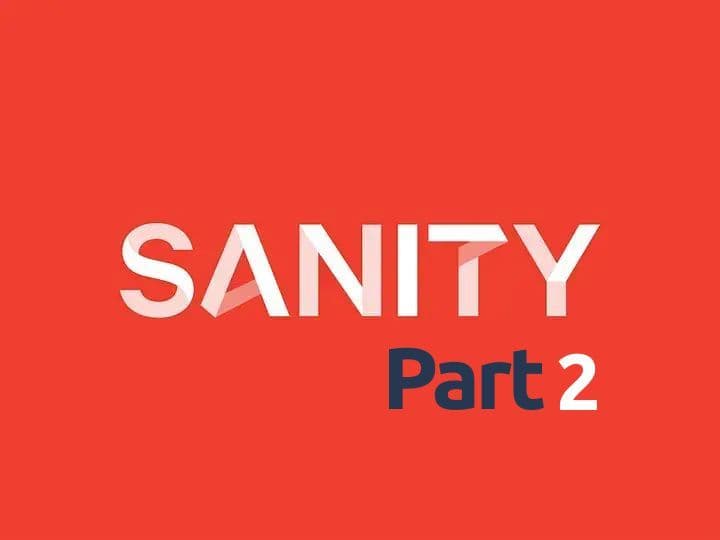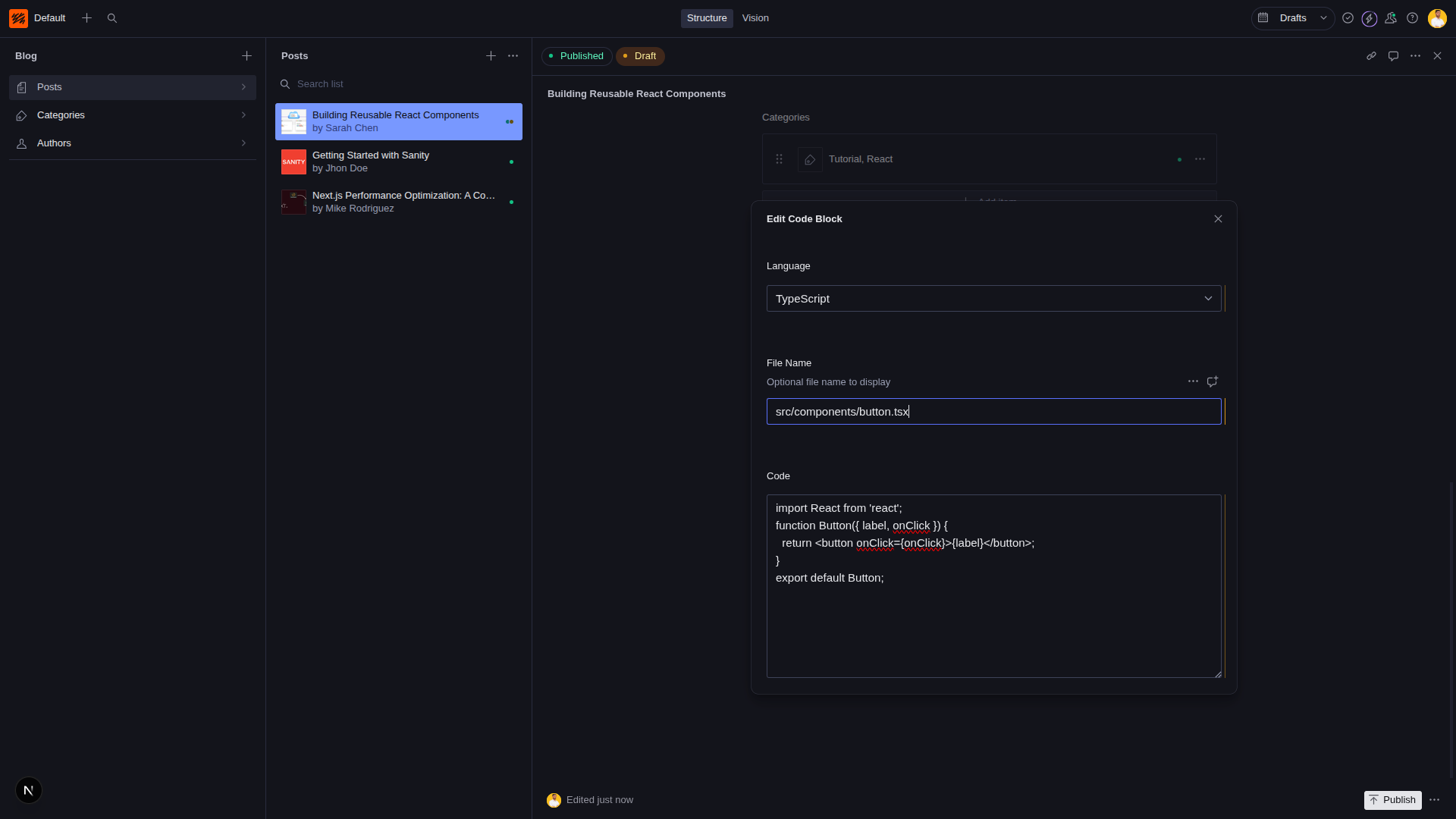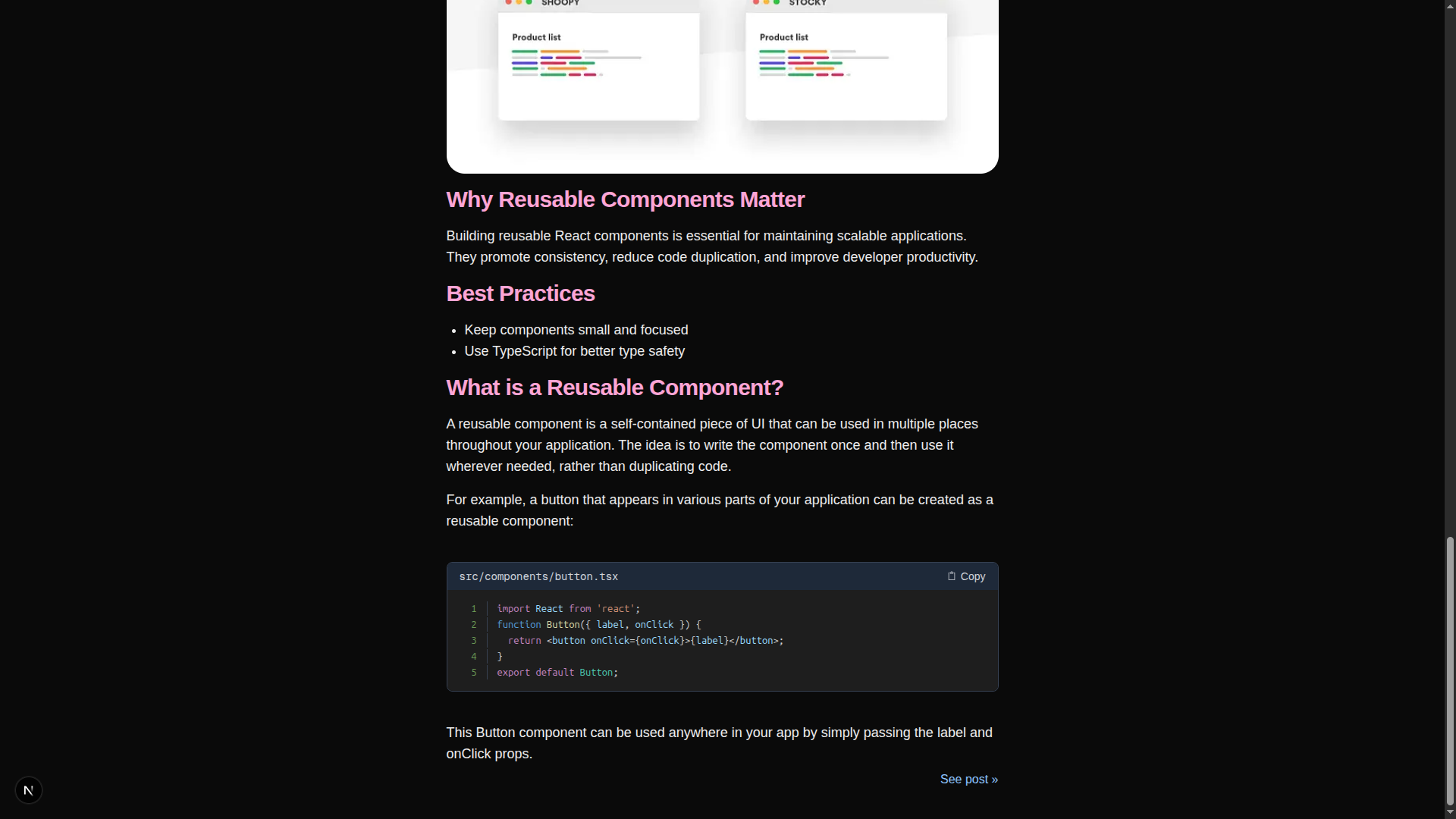

Step-by-Step Sanity Guide: Adding Code Blocks to Your Sanity + Next.js Blog
Part 1: Step-by-Step Sanity Guide: Setting Up Sanity.io with Next.js
Part 2: Step-by-Step Sanity Guide: Adding Code Blocks to Your Sanity + Next.js Blog
Introduction
Code blocks are essential for any technical blog. They allow you to share code snippets, configuration files, and terminal commands in a clean, readable format. In this guide, we'll walk through implementing beautiful, syntax-highlighted code blocks in your Sanity + Next.js blog.
What You'll Build
By the end of this tutorial, you'll have:
- A custom code block schema in Sanity Studio
- Syntax-highlighted code blocks on your frontend
- Copy-to-clipboard functionality
- Language-specific styling
Prerequisites
Before we start, make sure you have:
- A working Sanity.io + Next.js blog setup. (Click here to see how to make one)
- Basic knowledge of Next.js and Sanity.io schemas
Step 1: Create the Code Block Schema in Sanity
First, let's define a custom schema for code blocks in your Sanity Studio.
Create a new file src/sanity/schemaTypes/codeBlockType.tsx
1import { CodeIcon } from "@sanity/icons";
2import { defineType } from "sanity";
3
4export const codeBlockType = defineType({
5 name: "codeBlock",
6 type: "object",
7 title: "Code Block",
8 icon: CodeIcon,
9 fields: [
10 {
11 name: "language",
12 type: "string",
13 title: "Language",
14 options: {
15 list: [
16 { title: "JavaScript", value: "javascript" },
17 { title: "TypeScript", value: "typescript" },
18 { title: "HTML", value: "html" },
19 { title: "CSS", value: "css" },
20 { title: "Python", value: "python" },
21 { title: "Java", value: "java" },
22 { title: "PHP", value: "php" },
23 { title: "Ruby", value: "ruby" },
24 { title: "C#", value: "csharp" },
25 { title: "C++", value: "cpp" },
26 { title: "Shell", value: "shell" },
27 { title: "SQL", value: "sql" },
28 { title: "JSON", value: "json" },
29 { title: "Plain Text", value: "text" },
30 ],
31 },
32 initialValue: "javascript",
33 },
34 {
35 name: "filename",
36 type: "string",
37 title: "File Name",
38 description: "Optional file name to display",
39 },
40 {
41 name: "code",
42 type: "text",
43 title: "Code",
44 rows: 10,
45 },
46 ],
47 preview: {
48 select: {
49 language: "language",
50 filename: "filename",
51 code: "code",
52 },
53 prepare({ language, filename, code }) {
54 const title = filename
55 ? `${filename} (${language})`
56 : `Code block (${language})`;
57 const firstLine = code?.split("\n")[0];
58 return {
59 title: title,
60 subtitle: firstLine,
61 };
62 },
63 },
64});
65Step 2: Update Your Blog Post Schema
Next, add the code block to your blog post schema. Update your src/sanity/schemaTypes/blockContentType.ts file:
1import { defineType, defineArrayMember } from "sanity";
2import { ImageIcon } from "@sanity/icons";
3
4/**
5 * This is the schema type for block content used in the post document type
6 * Importing this type into the studio configuration's `schema` property
7 * lets you reuse it in other document types with:
8 * {
9 * name: 'someName',
10 * title: 'Some title',
11 * type: 'blockContent'
12 * }
13 */
14
15export const blockContentType = defineType({
16 title: "Block Content",
17 name: "blockContent",
18 type: "array",
19 of: [
20 defineArrayMember({
21 type: "block",
22 // Styles let you define what blocks can be marked up as. The default
23 // set corresponds with HTML tags, but you can set any title or value
24 // you want, and decide how you want to deal with it where you want to
25 // use your content.
26 styles: [
27 { title: "Normal", value: "normal" },
28 { title: "H1", value: "h1" },
29 { title: "H2", value: "h2" },
30 { title: "H3", value: "h3" },
31 { title: "H4", value: "h4" },
32 { title: "Quote", value: "blockquote" },
33 ],
34 lists: [{ title: "Bullet", value: "bullet" }],
35 // Marks let you mark up inline text in the Portable Text Editor
36 marks: {
37 // Decorators usually describe a single property – e.g. a typographic
38 // preference or highlighting
39 decorators: [
40 { title: "Strong", value: "strong" },
41 { title: "Emphasis", value: "em" },
42 ],
43 // Annotations can be any object structure – e.g. a link or a footnote.
44 annotations: [
45 {
46 title: "URL",
47 name: "link",
48 type: "object",
49 fields: [
50 {
51 title: "URL",
52 name: "href",
53 type: "url",
54 },
55 ],
56 },
57 ],
58 },
59 }),
60 // You can add additional types here. Note that you can't use
61 // primitive types such as 'string' and 'number' in the same array
62 // as a block type.
63 defineArrayMember({
64 type: "image",
65 icon: ImageIcon,
66 options: { hotspot: true },
67 fields: [
68 {
69 name: "alt",
70 type: "string",
71 title: "Alternative Text",
72 },
73 ],
74 }),
75 defineArrayMember({
76 type: "codeBlock",
77 }),
78 ],
79});
80Step 3: Register the Schema
Don't forget to register your new schema in the src/sanity/schemaTypes/index.ts file:
1import { type SchemaTypeDefinition } from "sanity";
2
3import { blockContentType } from "./blockContentType";
4import { categoryType } from "./categoryType";
5import { postType } from "./postType";
6import { authorType } from "./authorType";
7import { codeBlockType } from "./codeBlockType";
8
9export const schema: { types: SchemaTypeDefinition[] } = {
10 types: [blockContentType, categoryType, postType, authorType, codeBlockType],
11};Step 4: Add Code Block to Your Blog Body
Add a code block in Sanity Studio:
- Open your Studio at http://localhost:3000/studio
- Select a post
- In the body section, click the Code block button (</>)
- Fill in the required inputs (language, code, and file name)

Step 5: Install Frontend Dependencies
Now let's set up the frontend. Install the necessary packages:
1npm i react-syntax-highlighter @types/react-syntax-highlighterStep 6: Define the CodeBlock Type:
Start by adding a new type by creating the src/types/codeBlock.ts file
1export type CodeBlockType = {
2 language: string;
3 code: string;
4 filename: string;
5};
6Step 7: Implement the CodeBlock Component:
Create a new component src/components/CodeBlock.tsx
1"use client";
2import { useState } from "react";
3import { Prism as SyntaxHighlighter } from "react-syntax-highlighter";
4import { vscDarkPlus } from "react-syntax-highlighter/dist/cjs/styles/prism";
5import { ClipboardIcon, CheckmarkIcon } from "@sanity/icons";
6import { CodeBlockType } from "@/types/codeBlock";
7
8type CodeBlockProps = CodeBlockType;
9export default function CodeBlock({
10 language = "text",
11 code,
12 filename,
13}: CodeBlockProps) {
14 const [copied, setCopied] = useState(false);
15
16 const copyToClipboard = async () => {
17 try {
18 await navigator.clipboard.writeText(code);
19 setCopied(true);
20 setTimeout(() => setCopied(false), 2000);
21 } catch (err) {
22 console.error("Failed to copy code: ", err);
23 }
24 };
25
26 return (
27 <div className="my-6 overflow-hidden rounded-lg border border-gray-200 dark:border-gray-700">
28 {/* Header */}
29 <div className="flex items-center justify-between bg-gray-50 dark:bg-gray-800 px-4 py-2">
30 <div className="flex items-center space-x-2">
31 {filename && (
32 <span className="text-sm text-gray-600 dark:text-gray-300 font-mono">
33 {filename}
34 </span>
35 )}
36 </div>
37
38 <button
39 onClick={copyToClipboard}
40 className="flex items-center space-x-1 text-sm text-gray-600 dark:text-gray-300 hover:text-gray-800 dark:hover:text-gray-100 transition-colors"
41 title="Copy to clipboard"
42 >
43 {copied ? (
44 <CheckmarkIcon className="h-4 w-4 text-green-500" />
45 ) : (
46 <ClipboardIcon className="h-4 w-4" />
47 )}
48 <span>{copied ? "Copied!" : "Copy"}</span>
49 </button>
50 </div>
51
52 {/* Code */}
53 <div className="relative">
54 <SyntaxHighlighter
55 language={language}
56 style={vscDarkPlus}
57 customStyle={{
58 margin: 0,
59 borderRadius: 0,
60 fontSize: "14px",
61 lineHeight: "1.5",
62 }}
63 wrapLines
64 showLineNumbers
65 lineNumberStyle={{
66 minWidth: "3em",
67 paddingRight: "1em",
68 color: "#6b7280",
69 borderRight: "1px solid #374151",
70 marginRight: "1em",
71 }}
72 >
73 {code}
74 </SyntaxHighlighter>
75 </div>
76 </div>
77 );
78}
79Step 8: Update Your Portable Text Renderer:
Update the ProtableText component props in the src/components/blog.tsx file
1import { PostType } from "@/types/post";
2import { PortableText } from "next-sanity";
3import Image from "next/image";
4import React from "react";
5import CodeBlock from "./codeBlock";
6import { CodeBlockType } from "@/types/codeBlock";
7
8type CodeBlockProps = {
9 value: CodeBlockType;
10};
11
12type BlogProps = {
13 post: PostType;
14};
15
16export const Blog = ({
17 post: {
18 title,
19 author,
20 mainImage: { url, alt },
21 body,
22 },
23}: BlogProps) => {
24 return (
25 <article className="flex flex-col gap-4">
26 <h1 className="text-center text-4xl font-bold text-yellow-300">
27 {title}
28 </h1>
29 <span className="self-end capitalize font-semibold">
30 made by: <span className="text-orange-300">{author}</span>
31 </span>
32 <div className="relative aspect-[3/1.75]">
33 <Image
34 className="object-cover rounded-3xl"
35 src={url}
36 alt={alt}
37 priority
38 fill
39 />
40 </div>
41 <PortableText
42 value={body}
43 components={{
44 block: {
45 normal: ({ children }) => (
46 <p className="leading-7 sm:text-lg">{children}</p>
47 ),
48 h3: ({ children }) => (
49 <h2 className="text-pink-300 font-semibold tracking-tight text-xl sm:text-3xl">
50 {children}
51 </h2>
52 ),
53 },
54 list: {
55 bullet: ({ children }) => (
56 <ul className="sm:text-lg list-disc ml-6">{children}</ul>
57 ),
58 },
59 listItem: {
60 bullet: ({ children }) => (
61 <li className="marker:font-bold">{children}</li>
62 ),
63 },
64 types: {
65 codeBlock: ({
66 value: { language, code, filename },
67 }: CodeBlockProps) => (
68 <CodeBlock language={language} code={code} filename={filename} />
69 ),
70 },
71 }}
72 />
73 </article>
74 );
75};
76Step 9: Observe and Test the Results:
Run your Next.js project and check if the code block is rendered successfully

Make sure the copy to clipboard functionality works
Conclusion
You now have a fully functional code block system in your Sanity + Next.js blog! Your readers can enjoy syntax-highlighted code with copy functionality, and you can easily manage code snippets through Sanity Studio.
What You've Built
- Advanced Sanity schema for code blocks with line numbering and Premium syntax highlighting.
- Smart copy-to-clipboard with format preservation and success notifications.
The tutorial is designed to be beginner-friendly while including advanced features that make your code blocks professional and user-friendly. Each step includes complete code examples and explanations of what's happening.
Happy coding! 🚀
Part 1: Step-by-Step Sanity Guide: Setting Up Sanity.io with Next.js
Part 2: Step-by-Step Sanity Guide: Adding Code Blocks to Your Sanity + Next.js Blog